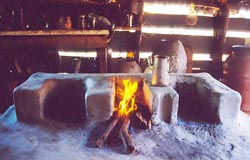
The Spanish golden age is a period in Spanish history. Culturally what defines the golden age is the blooming of the arts and literature. In Spanish it is called El Siglo de Oro (Golden Century), but it lasted much longer than a century and it doesn't have an exact beginning and end date, though it said to more or less have begun around 1492 with the reconquest, the discovery of America and the publication of Gramática de la Lengua Castellana by Antonio Nebrija (which marks the official birth of Castilian as a language). During the Spanish Golden Age, the country produced some of it's best literature, music, painting and poetry. As it happens the Hapsburgs, the ruling dynasty, at least for a while longer, were great patron of the arts . And the end of this golden period? It is calculated to have ended in 1681 at the latest when the last great writer Pedro Calderon de la Barca died.

During the Spanish golden age what is considered the first Spanish gastronomic treaty was published. This cookbook implies that cooking and cuisine is an act of pleasure and health. Many other culinary writers surge in this period, who wrote cookbooks about Courts cuisine or popular gastronomy.
With the culinary arts it was no different, though socially it was far more divided. On the one hand the Courts cooks prepared very elaborate dishes, always bordering (if not crossing over) on excess and with great abundance. On the other hand the popular gastronomy of poorer people was basically cumulative knowledge and tradition. Recipes were passed from mother to daughter for generations, though most of them did not follow an exact "formulas" as meals depended on economy and availability. Spain has always been mostly a rural country, and in many cases ingredients used came from the cook's own orchard.
While the King and his court dined on all kinds of meats, the commoners' diet was based on bread made of wheat or rye flour, and other products based on cereals. Meat was scarce and usually consumed for celebration purposes only, however salted bacon was more common. It was included in the different flour stews of the time (ollas)

However during the Spanish golden age the gentry ate wheat flour bread too and of course, much more meat. Not only the culinary customs changed at this time, but the way at sitting at the table and even a new cutlery became all the rage, consisting of knife, fork and spoon (yes, much as it is today) and the icing on the cake of refinement was the cumbersome use of a different knives according to the food on the plate. Sound familiar?
Many people were employed in the Courts in order to feed the royal family. There were several positions: kitchen porters, pastry makers, people in charge of spices, others dedicated to tripes, potaxier (responsible for vegetables), frutiers (responsible for fruit), waterboys, there was even a position called galopin, which basically meant being in charge of plucking the poultry's feathers! The kitchens and service was such a complex machine that had to be well oiled at all times and required huge spaces to work in.
As for the food in the tables of House of Hapsburg itself it was excessively copious and from literary references we know that one meal could encompass hundreds of dishes. The ingredients from the new world are slowly introduced in the Spanish culinary customs, however they didn't become widely spread until the 18th century when other products such as cereal were scarce. Another factor that contributed was a demographic growth which produced famine in most of Europe, including Spain. The potato became a fundamental food source.
Some of today's gastronomic tradition began in the Spanish golden age: salted fish in the interior regions, specially cod, the legume stews called ollas that still prevail, though with some variations, for instance olla podrida. Should you ever decide to visit Spain we recommend you to try some of these dishes, that exist since the time of Don Quixote. Popular culinary arts were had great Sephardic and Arab influences (such is the case with the mentioned ollas). The urban centers were ever more populated while the transport systems were greatly inadequate to fulfill the transit needs, something that produced localized famine. Meals beyond that day's could not be planned.
Food in the monasteries of the Spanish golden age were no less lavish and plentiful than in the courts. From the year 1607 snow became all the rage and the nobles at the Courts became ice-cream lovers, so much in fact that a large portion of the Courts' budget for food was spent on snow, that would be transported by mares from the Mountains of Guadarrama.
One of the main aspects of food in the Spanish golden age is the contrast between the abundance of food for the rich and nobles and hunger and famine of the poor; a breach that would surpass this beaming cultural period in Spain.